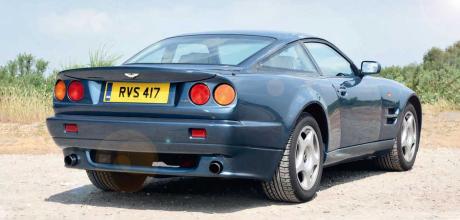1993 Aston Martin Vantage V600
With its twin supercharged 5.3-litre V8 resulting in huge performance, yet still having the kind of luxurious interior Aston was now renowned for, the Vantage was the quintessential British supercar of the Nineties. Thirty years after its debut, we explore its history and later development before taking one of these refined brutes for a drive.
WORDS & PHOTOGRAPHY PAUL WALTON
BRUTO FORCE VANTAGE V600
Four years after the Virage made its debut, a Vantage version finally made its debut in 1993. With the V8 of a later version producing 600bhp, it was the most powerful Aston to date
It seems a pity that during the Nineties MI5’s Q branch equipped James Bond with a series of boring BMWs when his preferred brand for almost 30 years, Aston Martin, had an absolute goliath of a car in its arsenal, the Virage-based Vantage. With a twin supercharged 5.3-litre V8, what it lacked in weapons and gadgetry it made up for with sheer brute force.
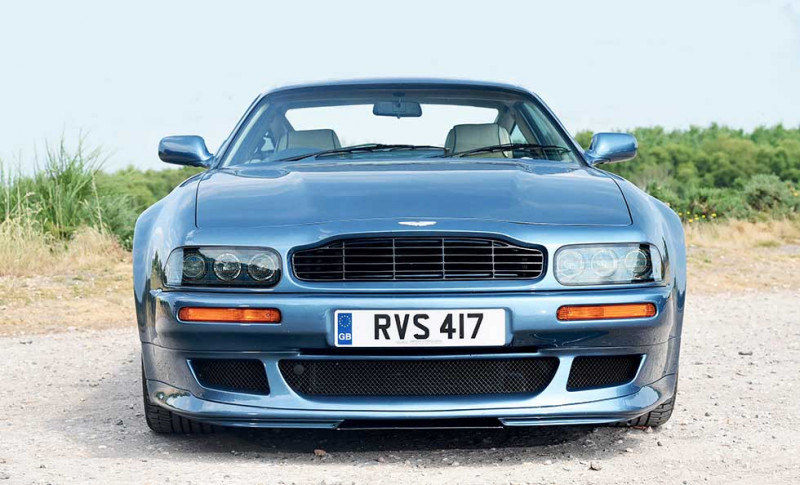
Perhaps the real reason why Q switched Bond over to a boring 5-Series was due to the time it took to arrive. Although the Virage had debuted in 1989, it would take another three years for the Vantage version to finally make an appearance, plenty of time for Q to lose interest and do a deal with MI5’s local BMW dealer instead.
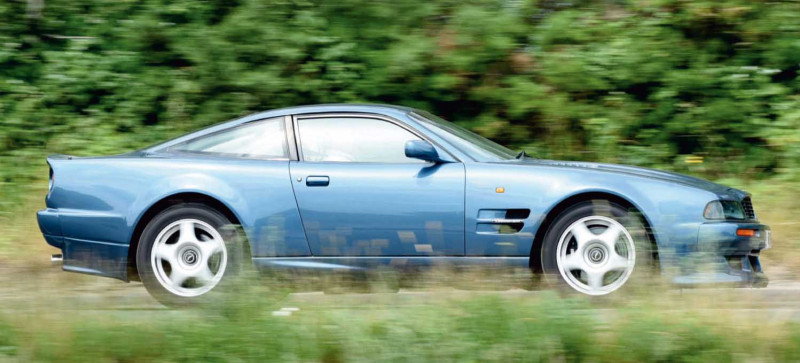
Yet with the updated 5.3-litre V8 fitted to the Virage capable of producing much more than 306bhp, there was always going to be a faster version. The issue was it needing a longer development time than previous generations of Vantages.
Work on the car (internally known as the DP2055) had already started by the time the first examples of the Virage were leaving the Newport Pagnell production line in late 1989. The first task for the team responsible for the car’s development was to decide the power the V8 would need if it was to achieve the 186mph they’d previously targeted as their top speed goal.
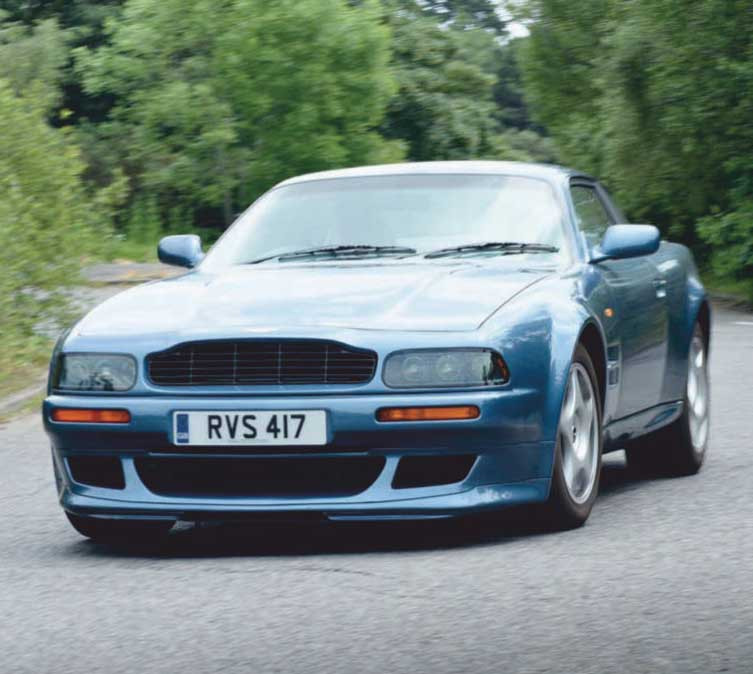
“A computer analysis of the power requirements for the performance targets had been conducted by Andrew Marsh who was the Vantage project manager,” said the man responsible for the engine, Arthur Wilson, in David Dowsey’s 2007 book, Aston Martin: Power, Beauty and Soul. “This analysis had initially identified a need for 486bhp. Later, this was to rise to 500.”
Rather than use the 6.3-litre version that the V8 Aston’s Works Service was currently offering to Virage owners who were wanting more power, Wilson decided to stick with the standard car’s 32-valve 5.3 instead meaning the extra power had to be found another way. “About the time that I was thinking about the Vantage, the Eaton company had done the Thunderbird using its M90 supercharger that looked about the right size and had a lot of product validation testing behind it for Ford,” continued Wilson. “My recommendation was that we go with the supercharger route and that we should do it in-house. [Aston’s then chairman] Victor Gauntlett and engineering director, Andrew Woolner, accepted my recommendation and we went ahead.”

With two Eaton superchargers fitted to the 5.3-litre, Wilson was able to get more and more power from the engine until he was told to rein it back by the project’s new manager, Mike Booth, who had taken over from Marsh in late 1990.
“The torque figure was in the 600-plus range,” continued Wilson. “We were on target for power at 500-plus horsepower, but the torque was raising concerns over transmission reliability. I changed the cam timing to push the power up-range, which gave a very flat torque curve and reduced the peak torque to a more tolerable 550lb ft. Power went up to 550bhp which is why we came to overshoot the horsepower target for the project.”
As a way to enable the engine to cope with the extra power, a new crankshaft and Cosworth pistons were required. The V8 was then mated to the same ZF sixspeed manual box as those Virages fitted with the 6.3-litre To counteract the axle tramp (or wheel hop) that the early prototypes suffered from, caused by the increased power, the car needed substantial suspension changes such as stronger springs and shock absorbers, but this resulted in an overly harsh ride. The answer was a torque tube, a stationary housing around the driveshafts that holds the rear end in place during acceleration and braking. “A prototype tube was made by folding up steel plate, which was used in the chassis. We cut the mounting off the existing axle and welding them to it. It was a totally standard propshaft complete with universal joints,” said Steve Bolton, principal engineer for Aston’s Special Vehicle Operations, in Power, Beauty and Soul. Despite the ad hoc design, it was kept throughout the Vantage’s production run. “It wasn’t bettered and there was no need for a redesign,” continued Bolton. “If it works, why change it?”
A year after becoming Aston Martin’s chairman in late 1991, former Ford vicepresident Walter Hayes had made his friend (Sir) Jackie Stewart an executive director of the company. The three time F1 World Champion was then brought in to help develop the Vantage on the road, driving the car before and after the torque tube had been added. “If a car has a lot of power and performance, it becomes all the more critical to see that it’s always balanced and under precise control,” explained the Scot about his involvement during a 1993 interview. “That’s why we take such trouble with the subtleties when refining a car like this.”
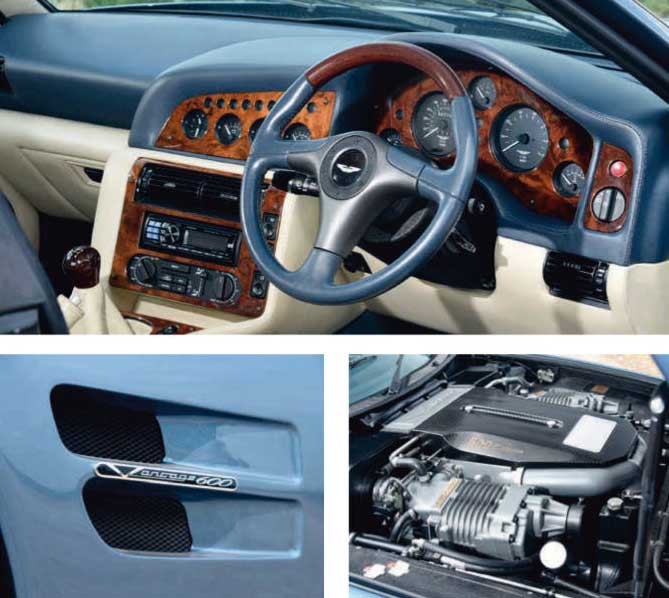
Aesthetically, the Vantage was closer to what the designers, John Heffernan and Ken Greenly, had originally envisaged for the Virage, but which had been watered down by Aston Martin. And so, with its six square headlights under rectangular Perspex covers, twin side vents plus substantially flared wheelarches to accommodate the larger wheels and tyres, the result was a much leaner and aggressive car than what it was based on. The Virage’s original VW Scirocco-sourced rear light clusters had been swapped for more stylish individual circular units while an inbuilt rear spoiler helped to promote 150-170lb of downforce. The car’s drag was also improved having a Cd figure of 0.34 compared to the Virage’s 0.356. So major were the changes, only the roof and door skins were carried over.
The interior was also updated with electrically heated Recaro seats, a new dashboard layout, more veneer plus a four-spoke steering wheel from the Lincoln Town Car.
The result was a handsome and distinctive car, arguably more so than the Virage, but with 550bhp, it was also the most powerful production Aston Martin. With a 186mph top speed and a 0-60mph time of 4.6 seconds, this made it one of the world’s fastest cars at the time. This made it different from the one it was based on which had never gone down well with the critics. So when the new model finally made its debut at the 1992 British Motor Show, the Virage name had been dropped and it was simply called the Vantage. “We thought, ‘Let’s not remind anyone’ and got rid of the word,” said Steve Waddingham in a 2021 interview who back then worked for Aston and continues today as the company’s historian. “This was a different animal.”
At £177,600, it was £46k more than the Virage and over thirty grand more than its nearest rival, the Ferrari 456GT. Yet the press were still largely positive when the car fi nally went on sale a year later. “What the Vantage is, and what cars like the Virage, Volante and Zagato are not, is a real Aston Martin; a big, very beautiful, very fast albeit expensive GT with so much appeal and purpose behind it that it is more an experience than it is mere transport,” was Autocar & Motor magazine’s verdict in its 25 August 1993 issue.
Unsurprisingly, it was the reserve of the rich and famous. Adam Clayton, the bass guitarist from the Irish rock band U2, had one as did Elton John while the Sultan of Brunei specified his Vantage with an automatic gearbox.
By being expensive and largely handbuilt, taking around 1,200 hours to construct when a Ford Fiesta took just eight, even by Aston Martin’s standards the Vantage was unsurprisingly never a strong seller. In six years around 250 Vantages were produced making it one of the British company’s most exclusive models from the past three decades.
The final nine were a special edition that celebrated Aston Martin’s win at the 1959 24 Hours of Le Mans. Debuting in 1999, these Le Mans models featured five-spoke magnesium alloy wheels with centre caps, a blanked radiator with twin openings, bonnet cooling ducts and redesigned wing vents similar to those of the race-winning DBR1.
Yet this wasn’t the only special version Aston would develop for this already special car. In the mid-Nineties, Steve Bolton and Arthur Wilson were putting together an even more powerful example of the supercharged 5.3-litre V8 for an overseas customer to counteract it losing power in hot weather.
“One of the concerns with the car in extreme climates was that the intercooling system wasn’t as efficient as it could have been,” said Steve Bolton in Power, Beauty and Soul. “We needed to liberate more power. As well as revise the superchargers and exhaust system to improve the intercooling system and thus, the performance was a necessity.”
The pair found by increasing the cooling they could take advantage of the increased charge being developed by the new superchargers, resulting in 600bhp. Although developed for an individual client, Aston still decided to off er the upgraded engine as an aftermarket package for existing Vantage owners. According to Steve Bolton in Dowsey’s book, the V600 name came from simply where the car sat in Aston’s project list. “The previous project number was 590, so this became 600. It was just the next series of numbers. It was coincidental that that was also the power output.”
But unlike the original (now universally but unofficially known as the V550), it was never a type-approved model; customers brought their existing Vantages back to Aston’s Works Service for the conversion. And neither was it a particular specification; owners simply picked the upgrades they wanted from a menu meaning of the 50 produced, none were identical. There wasn’t a time limit either with some cars – such as the one featured here – not having the alterations completed until well into the 2000s. Even today, Aston’s Works Service department could technically still transform a V550 into a V600.
Other changes available as part of the V600 package included AP Racing brakes with six-piston calipers front and rear while the existing rear brake caliper was reused as a park brake. The ZF manual gearbox was also turned into a five-speed close-ratio unit by having the sixth gear blanked off.
The front and rear suspension systems were completely reworked and incorporated stiff er Eibach springs, Koni adjustable sports dampers and a stiff er anti-roll bar. Traction control was also offered. Finally, the cars were fitted with special 18in, five-spoke alloys by Dymag shod with sticky Goodyear Eagle tyres. Visually, the V600 differed little from the standard Vantage, only set apart by a revised Works Prepared chrome grille surround plus subtle V600 badging on the boot lid and side vents.
When the V600 upgrade was revealed at the 1998 British Motor Show at Birmingham’s National Exhibition Centre, from its (proposed) 200mph top speed to the £233,682 price tag (including car), everything about it was big, bold and brashy.
And 25 years later, judging by the gorgeous Chichester Blue example in front of me, it’s clear nothing has changed. While its immediate replacement, the Ian Callum-designed Vanquish from 2001, is a relatively discreet and elegant gentleman’s carriage, this isn’t something you can say about the Vantage. Yet I still find the car’s hard, uncompromising and chiselled lines attractive and, together with the six headlights, flared wheelarches and huge 18in wheels, this gives the car more of a muscular presence than the boxer Conor McGregor would in a public gym.
With this being a 1998 model, it features round rather than square headlights plus Jaguar-sourced wing mirrors instead of the same Citroen CX versions as the DB7 that were fiitted to the early examples. A new sports exhaust was also available around this time. Later cars then had door handles from the Ford Mondeo complete with an integrated key hole plus a revised cooling system.
First registered on 1 January and supplied new by Stratton Motor Company in Norfolk, the car’s first owner was Viscount Rothermere, the chairman of the company that owns the Daily Mail. He sold it three years later when it had 11,000 miles on the clock via Stratton to a Mr James Grundy of Bolton.
In April 2003, the blue Vantage was sent to Aston’s Works Service department for a partial V600 upgrade that consisted of a close-ratio gearbox modification plus the sports exhaust which together cost £10,724. It returned to Newport Pagnell a year later for the uprated brakes (costing another £13,000) and in 2006 it finally had the 600bhp engine upgrade plus the same style of wheels as the Le Mans edition that had a combined cost of £11,500. Although the V600 badges were added, it kept the original radiator grille.
The aggressiveness of the car’s exterior makes for a strange juxtaposition with the very traditional interior. Apparently it took the hide of nine cows – otherwise known as a ‘herd’ – to upholster the Vantage’s interior and from the handsome if firm Recaro seats to the dash top, it’s everywhere. It’s not known how many trees were felled for the veneer, but since it’s covering every other surface, it must have been a forest worth. Instead of the plain and cheaplooking plastic binnacle of the early Virage I tested for issue four of AMD, the five now separate dials are housed in a single piece of veneer directly in front of the driver.
Thankfully, the bland Lincoln-sourced steering wheel has been swapped for the optional and much more appropriate three-spoke by the Italian manufacturer, Nardi.
Once you’ve forgiven the Ford-sourced switchgear for the ventilation plus the exposed Torx screw heads dotted across the fascia, it’s still beautifully put together. Whereas its cheaper rivals were mass produced by robots, judging by its fit and finish, the Aston was clearly handmade by Newport Pagnell’s artisan craftsmen. It offers a very elegant, calming and comfortable ambience that lasts until the moment I turn the key and fire the goliath of an engine in front of me.
The V8 starts instantly, sounding louder than if I was stood next to a jet engine. If the car’s size and aggressive demeaner didn’t reveal what it’s true intensions were, then I just got a pretty good idea.
Yet to begin with, I find the Vantage surprisingly easy to drive. Although the five-speed gearbox can be stiff and notchy, with the V8 offering 606lb ft of torque, it’s not always necessary to change down, accelerating as keenly in fifth as most cars do in third.
The suspension is surprisingly pliable for such a powerful car and although fi rm, it’s never back-breakingly so. Finally, the AP brakes might be razor sharp but they’re still progressive and controllable by the sole of my size ten boot.
And then on an empty stretch of the road, I dip the clutch, manage to slip the transmission down to third and nail the throttle hard. Have you seen the bit in Stanley Kubrick’s 2001: A Space Odyssey when astronaut Dave Bowman goes through the monolith Stargate and everything becomes a blur? It gives an idea of what the Vantage is like at speed. Unbelievably yet effortlessly fast, with so much power, the car is propelled forward with a velocity that my subconscious takes a split second to take in. And unlike turbocharged supercars such as the Jaguar XJ220, there’s no lag, the Eaton superchargers being constantly spooled up and ready to deliver their deadly punch.
With so much torque, the revs keep rising until the engine’s once deep growl becomes a higher pitched wail and I finally press the clutch and snatch fourth ready for the exhausting process to start again. From the Ferrari 3.0-litre V12 of the Fifties and Sixties to BMW’s 5.0-litre V10 in the E60 generation of M5, I’ve experienced some magnificent engines over the years. But in terms of sheer brute force as well as theatrics, nothing matches the 600bhp version of Aston’s 5.3-litre V8.
It needs all that power too since, by tipping the scales at just under 2,000kg, the Vantage is no agile sportscar that can be flicked from one direction to another but a big, uncompromising bruiser. Yet treat it with respect and, despite too much body roll that can occasionally cause the car to float around a little through fast corners, it can be made to hustle through roundabouts relatively quickly. But you’re always aware of its desire to swap ends at the exit of a corner.
As Autocar & Motor said in 1993 when testing a V550, “The only way you can avoid this is to either lose some speed or find a better road.”
Yet these criticisms don’t take away what a truly magnificent machine the Vantage V600 is. Big, uncompromising and monstrously fast yet still having the same handmade feel of Aston’s earlier cars, which has been sadly lost in recent years. Although the 2001 Vanquish was the last to be produced at Newport Pagnell after assembly moved to a new facility outside Gaydon, Warwickshire in September 2003, in terms of drivability and usability it was much more mainstream than the Vantage with less of its hand-crafted feel. Despite its relative rarity, it makes the Vantage an incredibly important model in Aston’s long history. Q might not have got chance to equip one with guns and gadgets, but thanks to its power, performance and handmade feel, it was already special enough without them.
Thanks to: Owner of the Vantage V600 featured here, Rob Smith. The car is currently for sale and anyone interested can contact him at rob@ slotraccoon.co.uk


